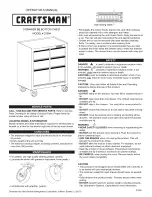
16
subzero temperatures. In warmer weather, parts can become hot, and temperatures should be
regularly checked during use, especially the temperature of metal parts.
CARE AND MAINTENANCE
If proper care and maintenance is provided, it will provide all jumpers with years of exercise,
fun, and enjoyment as well as reduce the risk of injury. Please follow the guidelines listed
below.
It is vital that the equipment is checked for wear, damage or missing parts regularly and often
by an adult. The complete product should be checked at least once a month, with particular
attention being paid to all connections and fastenings. If any parts exhibit signs of wear or
tear, they may need to be replaced. Failure to do this may result in the product malfunctioning
and causing injury.
o
Make sure all the spring connections (securing pins) are intact and cannot get loose
during jumping.
o
Check the trampoline for sharp edges. Replace any damaged part you find.
o
Make sure the mat and the padding are not damaged.
o
Make sure the strap fasteners are secured tightly.
The product must not be used until properly and fully installed and checked. Galvanized bars
may require occasional maintenance. If surface rust appears, it should be removed with either
a wire brush or coarse sandpaper, and the area should be coated with a non-toxic paint.
To avoid damage to the safety net, do not allow pets or other animals inside. Their claws and
teeth can damage the netting or the trampoline mat.
Make sure that no bonfires are lit close enough to threaten your trampoline and safety net. In
windy conditions, sparks and embers can travel significant distances and burn holes in both
the safety net netting and the trampoline mat.
Any large trampoline, with or without a safety net, can be blown around in high winds and
cause injury or damage. We recommend that the safety net should be removed under these
conditions and stored in a dry place. A trampoline without a safety net should be either
disassembled or moved to a sheltered place.
Any modifications made by the user (e.g. installing accessories) must be according to the
instructions of the manufacturer.
Over time, the durability of the trampoline parts is compromised by sunlight, rain, snow and
extreme temperatures. During winter, the trampoline can be damaged by the fallen snow or
freezing temperatures. It is recommended to store the mat inside.
Another option is to tie the round, outside portion (top frame) of the trampoline to the ground
using ropes and stakes. To ensure security, at least three (3) tie downs should be used. Do
not just secure the legs of the trampoline to the ground because they can pull out the frame
sockets.
If you need to move the trampoline, two people should do it. All the connection points should
be wrapped secured with weather resistant tape, such as duct tape. This will keep the frame
intact during the move and prevent the connection points from separating. When moving, lift
the trampoline slightly off the ground and keep it horizontal. For any other type of moving, you
should disassemble the trampoline. EVERY TIME YOU MOVE THE TRAMPOLINE, CHECK
IT FOR DAMAGE AFTERWARDS.
TERMS AND CONDITIONS OF WARRANTY, WARRANTY CLAIMS
General Conditions of Warranty and Definition of Terms
All Warranty Conditions stated hereunder determine Warranty Coverage and Warranty Claim
Procedure. Conditions of Warranty and Warranty Claims are governed by Act No. 40/1964 Coll. Civil



































